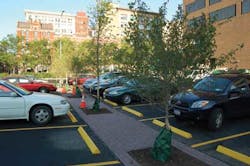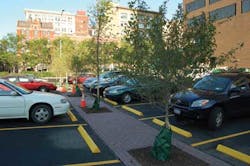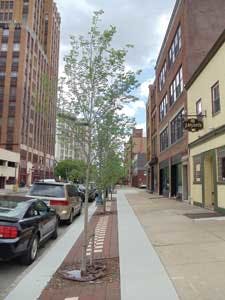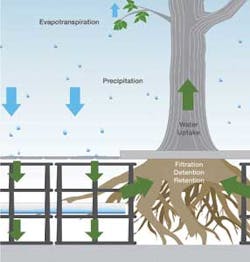Program Turns to Nature to Manage Pollution, Stormwater Runoff
By Matthew J. Millea
The past 100 years have taken a toll on Onondaga Lake, which has given its shores and water to support industrial commerce, a regional transportation hub and urban wastewater utilities in the City of Syracuse. The factories that once lined the lake have nearly disappeared but the hard-driving industrial century took its toll, turning the lake into one of the most polluted in North America.
The community in upstate New York is looking to nature for solutions. A comprehensive green stormwater management movement called Save the Rain is Onondaga County's plan to clean Onondaga Lake and manage the city's stormwater by using green utilities.
The apex of the lake pollution crisis came in 1998, when a federal court, via the Environmental Protection Agency, put a Consent Judgment in place to improve water quality in Onondaga Lake and its surrounding tributaries. The county responded with aggressive planning, and in 2009 presented the federal court with an innovative approach balancing gray infrastructure with green infrastructure for water management.
The order outlines several key steps through 2018 to prevent pollution, including sewer improvements and the Save the Rain plan to reduce sewer overflow generated by an annual 39 inches of rainfall and snow.
The county couldn't manage its wastewater and stormwater through a century-old sewer system that delivered pollution to the lake. So, it made dramatic improvements at the wastewater treatment plant and initiated several sewer separation projects to improve water quality and manage stormwater runoff. This is coupled with the Save the Rain program.
Green Solutions by Save the Rain
Save the Rain came together with intense community brainstorming and new leadership. Armed with an environmentally friendly vision, County Executive Joanne Mahoney united with partners throughout the community to support the area's new "green" movement. She listened and built task forces to develop Save the Rain.
The plan focuses on several large-scale and many smaller scale green projects that use sustainable solutions for capturing stormwater runoff, before it enters into the sewers and causes heavy flow periods that overflow the system. The program includes over 50 distinct green infrastructure projects to return water to the ground instead of the sewer system, and ultimately Onondaga Lake.
The goal by 2018 is to be able to capture 250 million gallons of stormwater through green utilities and an urban forest. In addition, the program aims to reduce levels of lake bacteria and nutrients, especially phosphorous.
The first of the new "green" projects was a city parking lot, which had previously utilized traditional asphalt with catch basin inlets that drained directly to the combined sewer system. The new parking lot design includes several features to collect stormwater on-site, thereby preventing it from ever reaching the sewer system. As an example, an island of porous pavers with six trees now captures the stormwater and this new feature acts like a sponge to soak up rainwater and percolate it into the soil below the asphalt parking.
Urban Forestry in Syracuse
Another component of Save the Rain is an urban forestry planting strategy for neighborhoods throughout the city. This collaborative initiative supports the planting of 8,500 trees and rain gardens by the community and contractors in locations throughout the combined sewersheds.
Tree plantings are important to Syracuse's strategy because they will contribute to the capturing of 250 million gallons of rain annually. Trees, especially those with large canopies, naturally intercept stormwater and their root systems use the precipitation to take up nutrients in the soil.
According to the Maryland Department of Natural Resources, the majority of trees in urban environments live for less that 10 years. This leads to a short and expensive planting and replacement cycle. It also deprives the community of the majority of the tree's benefits and cost savings, which are the most significant once the tree reaches maturity.
A large tree with a 30" trunk diameter provides 60-70 times the ecological services of a tree with a 3" trunk diameter, according to a U.S. Forest Service study. It explains that the leaves of large trees provide greater rainwater interception. The bigger the tree, the more interception it provides.
Green infrastructure specialist CH2M HILL, Onondaga County's Green Infrastructure Program Manager, worked with the city to outline a plan for favorable growing conditions. Key ingredients to growing large urban trees include large quantities of high-quality uncompacted soil, adequate drainage and irrigation, and aeration.
Onondaga County created favorable ground structures for its trees with the help of DeepRoot, the producers of the Silva Cell, an innovative underground growing system. The Silva Cells support the sidewalk while providing plenty of space for lightly compacted planting soil to support the growth of mature healthy trees.
Construction is now complete for the city's first streets using Silva Cells, Water Street and University Avenue. Many other street improvements and tree plantings are underway.
Teamwork and Lessons Learned
Save the Rain wouldn't have been possible without the collaboration between the county, city, local universities, community partners, residents and environmental specialists.
Representatives from the county's Department of Water Environment Protection, City of Syracuse Engineering Department, law departments from the county and city as well as offices of both the County Executive and Mayor, have worked tirelessly.
And their collaboration is paying off. Recently the EPA selected the community of Onondaga County and Syracuse as one of the nation's top 10 green infrastructure partners. The county also has been honored by the EPA Region 2 with its Environmental Leadership Award for the Save the Rain Program.
For her leadership and vision, County Executive Joanne Mahoney was recognized last year as a top 10 Public Official of the Year by the Governing Institute. She also was given the New York Water Environment Association Frank E. Van Lare Award for her leadership on the program. The award is given to elected officials who have made substantial and meaningful contributions to advancing effective water quality environment programs.
The community provides lessons to the water management industry. First, even under the harshest conditions, a green strategy for water management can be done. Secondly, green strategies can be effective. And lastly, the plan needs to come with a robust, long-term commitment for maintenance.
With its environmental efforts, Onondaga County aims to attract more residents to Syracuse, and for the first time in a long time, its population is on the rise. The community attributes this, in part, to its efforts to improve the quality of life through an environmentally friendly infrastructure strategy.
About the Author: Matt Millea is Deputy County Executive for Physical Services, Onondaga County. He was appointed to his current position in May 2012 by Onondaga County Executive Joanne Mahoney. He has more than 12 years of public service, having served three New York State governors. He has focused his professional efforts on helping to preserve and protect New York State's invaluable natural resources, as well as working in water quality projects throughout New York state.



